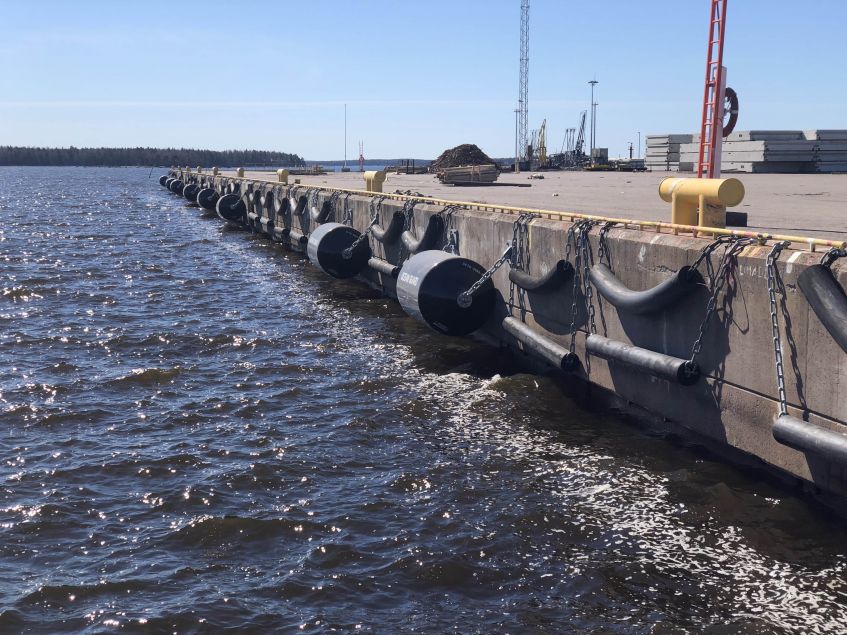Recent Posts
Marine Fenders – Current Hot Topics
Blog Post by: Rob Williams
July 31, 2020

As a follow up to the article, Marine Fender Design – Is It Important? this article discusses some of the current hot topics related to the design, manufacture, and maintenance of fender systems. As the design of fender systems continues to evolve, should we be looking again at some of the inherent design approaches that may impact on fender functionality and durability and in some cases, be considered to contribute to vessel damage?
Vessel Hull Pressure
The interaction of fenders with a vessel’s hull is fundamental to vessel berthing and mooring. A fender panel that is too small, or a vessel approach that is too fast, could result in damage to both the vessel hull and the fender system.
With the wide range of vessel types to consider and the fact that the current fender system design approach does not account for the flexing of a vessel’s hull during berthing, is sufficient information and guidance available to the fender designer about the average pressures that can be exerted on a vessel’s hull? Further investigations into the potential fatigue effects of repeated flexing of the vessel hull plate may be beneficial. It may be surprising to realise that loads from fender impacts are often not a specified criterion when it comes to new vessel hull design.
Continued interaction between maritime civil engineers and naval architects is intended to develop the understanding between disciplines, which may ultimately allow larger vessels to be safely accommodated safely at existing berths.
Vessel Belting or Rubbing Strakes
The understanding behind the inclusion of belting in the design of some vessels, is a topic which has potentially ‘fallen through the gap’ in recent years. It has led some fender designers to question why belting is provided, particularly when a fender system aims to provide a robust, yet energy absorbing berthing interface.
Fender designers assume that beltings are positioned along strong points of the vessel (such as a deck line), to act as a rubbing strip and to protect the vessel. Whilst considered to be correct, it is also understood that beltings fall outside of class requirements. As such, they are often considered to be a sacrificial element and are not always subjected to rigorous design. This reality can lead to challenges in identifying the belting strength, which is needed to correctly design the fender panel. It would therefore appear that both the fender system and the vessel belting are attempting to do the same job.
The problem is that a poorly maintained belting can cause damage to a fender panel. A poorly designed fender system can cause damage to a vessel’s belting and/ or hull. Unfortunately, ports often consider vessel belting to be the culprit for a range of damages to fender panels. It is a distinct possibility that the damage to the belting has occurred through contact with other, poorly designed or maintained fenders.
Best practise by vessel owners currently includes for the regular inspection, maintenance and prompt repair of vessel belting to prevent fender panel damage. This should be allied with the robust design and regular maintenance of fender panels by ports to ensure the berth interface remains in optimum condition.
Checking Fender Capability
The testing of a fender’s capacity, prior to installation, to absorb energy is a challenging and costly exercise. It is limited primarily by the availability of suitable test facilities. None-the-less, it is a necessary task undertaken to ensure that the fender design requirements have been achieved during manufacture. A fender manufactured from a low-quality rubber compound may appear suitable when initially installed but could result in damage to the vessel and quay structure when used during berthing.
In recent years, the identification of anomalous fender verification results has led to proposals that independent testing of all fenders following manufacture, is needed. Work is currently ongoing to establish an updated testing specification, which can be used across the fender industry to provide confidence to ports and vessel operators that the installed fendering achieves the required standard.
Fender Maintenance
A fender system is typically designed to have a serviceable life in the order of 20 to 25 years. During this time, regular maintenance and inspection, as recommended in the OCIMF Jetty Maintenance and inspection guidelines 2008, should be conducted. However, it is also common for fenders to be missed off the regular inspection and maintenance regime. Provided that they are still ‘hanging from the berth’, those persons inexperienced in identifying the early stages of fender degradation, can sometimes miss the early indications of maintenance requirements.
It is important to realise that the capacity and functionality of poorly maintained fenders can reduce over time. This results in a fender that is more susceptible to damage and more likely to damage visiting vessels. One option available to Ports is the in-service testing of fenders. This test can ensure that the fender rubber can still function within the required parameters. This is seldom undertaken as it can often be cheaper to replace the fender rubber, than have it tested at a capable facility. The lack of adequate maintenance to the fender system could contribute to additional fender and vessel damage alike.
Waves Group is a member of PIANC’s International Working Group MarCom WG211, “Guidelines for the Design of Fender Systems”.

